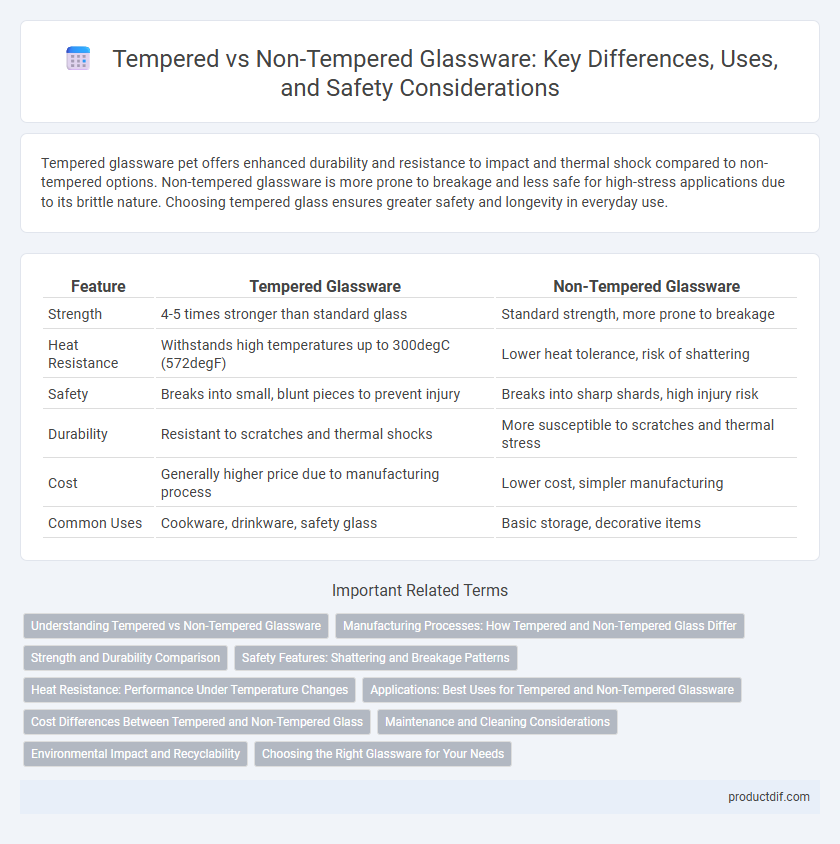Tempered glassware pet offers enhanced durability and resistance to impact and thermal shock compared to non-tempered options. Non-tempered glassware is more prone to breakage and less safe for high-stress applications due to its brittle nature. Choosing tempered glass ensures greater safety and longevity in everyday use.
Table of Comparison
| Feature | Tempered Glassware | Non-Tempered Glassware |
|---|---|---|
| Strength | 4-5 times stronger than standard glass | Standard strength, more prone to breakage |
| Heat Resistance | Withstands high temperatures up to 300degC (572degF) | Lower heat tolerance, risk of shattering |
| Safety | Breaks into small, blunt pieces to prevent injury | Breaks into sharp shards, high injury risk |
| Durability | Resistant to scratches and thermal shocks | More susceptible to scratches and thermal stress |
| Cost | Generally higher price due to manufacturing process | Lower cost, simpler manufacturing |
| Common Uses | Cookware, drinkware, safety glass | Basic storage, decorative items |
Understanding Tempered vs Non-Tempered Glassware
Tempered glassware is heat-treated to enhance strength, making it four to five times more resistant to impact and thermal shock compared to non-tempered glass. Non-tempered glass is more prone to shattering upon impact, breaking into sharp, dangerous shards, while tempered glass breaks into small, blunt granules, reducing injury risk. Understanding these differences is crucial for selecting safer, more durable glassware in kitchens, laboratories, and industrial applications.
Manufacturing Processes: How Tempered and Non-Tempered Glass Differ
Tempered glass undergoes a specialized thermal or chemical treatment process that rapidly heats and cools the glass to increase its strength and resistance to impact, while non-tempered glass is produced through a standard annealing process where it cools slowly to relieve internal stresses. The manufacturing process of tempered glass results in a tougher, more durable product that shatters into small, blunt pieces rather than sharp shards, making it safer for applications like automotive windows and shower doors. Non-tempered glass lacks this strengthening treatment, making it more susceptible to breakage with sharp, hazardous fragments.
Strength and Durability Comparison
Tempered glassware undergoes a thermal or chemical treatment process that enhances its strength, making it up to five times stronger than non-tempered glass. This increased durability allows tempered glass to resist impact and thermal stress, reducing the risk of shattering under everyday use. Non-tempered glass, while more prone to breakage, often shatters into sharp, hazardous shards, whereas tempered glass breaks into small, blunt pieces, improving safety in case of damage.
Safety Features: Shattering and Breakage Patterns
Tempered glassware is engineered with heat treatment to enhance strength, causing it to shatter into small, blunt granules upon breakage, significantly reducing injury risks. Non-tempered glass breaks into sharp, jagged shards that pose higher safety hazards during accidents. This difference in shattering patterns makes tempered glassware a safer choice for environments requiring impact resistance and user protection.
Heat Resistance: Performance Under Temperature Changes
Tempered glassware withstands rapid temperature changes up to 240degC due to its heat treatment process, making it highly resistant to thermal shock. Non-tempered glass lacks this treatment and can crack or shatter when exposed to sudden temperature fluctuations. This superior heat resistance of tempered glass ensures safer use in microwaves, ovens, and stovetops compared to non-tempered alternatives.
Applications: Best Uses for Tempered and Non-Tempered Glassware
Tempered glassware is ideal for applications requiring enhanced durability and safety, such as baking dishes, oven-safe containers, and drinkware exposed to thermal shock. Non-tempered glassware suits decorative uses, like serving bowls and display items, where strength is less critical and clarity or aesthetic appeal is prioritized. Tempered glass resists breaking into sharp shards, making it preferable for high-impact environments, while non-tempered glass offers cost-effective options for everyday, low-stress applications.
Cost Differences Between Tempered and Non-Tempered Glass
Tempered glass generally costs 20-40% more than non-tempered glass due to its manufacturing process, which involves heat treatment to enhance strength and safety. This higher price reflects the added durability, impact resistance, and compliance with safety standards required for architectural and automotive applications. Non-tempered glass remains less expensive but is more prone to breakage and less suitable for environments demanding safety glass.
Maintenance and Cleaning Considerations
Tempered glassware offers enhanced durability and resistance to thermal shocks, allowing safer use with hot liquids and easier cleaning without fear of sudden breakage. Non-tempered glassware requires gentler handling during maintenance, avoiding extreme temperature changes and abrasive scrubbers to prevent cracks or chips. Proper care for both types includes using mild detergents and soft cloths, but tempered glassware withstands rigorous cleaning routines more effectively.
Environmental Impact and Recyclability
Tempered glassware undergoes heat treatment that enhances strength but complicates recycling due to altered molecular structure, making it less environmentally friendly compared to non-tempered glass. Non-tempered glass is easier to recycle because it retains its original chemical composition, reducing energy consumption and emissions during processing. Choosing non-tempered glassware supports lower carbon footprints and more sustainable circular economies in the glass industry.
Choosing the Right Glassware for Your Needs
Tempered glassware offers enhanced durability and heat resistance, making it ideal for everyday use and environments prone to impacts or temperature fluctuations. Non-tempered glassware provides a more elegant appearance but is more fragile and suited for light, careful handling at events or formal settings. Selecting the right glassware depends on balancing the need for strength and safety with the desired aesthetic and usage frequency.
Tempered vs Non-tempered Infographic

 productdif.com
productdif.com